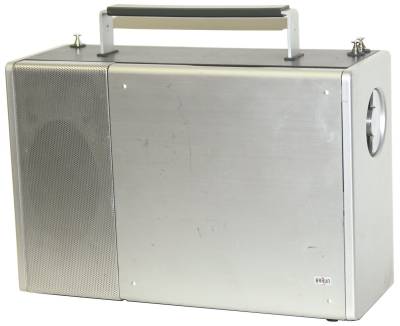Inhaltsverzeichnis
Braun T1000
Manufactured by Braun, Frankfurt.
In the mid-1960s, Braun released a world band receiver that caused a sensation due to its design and was popular with members of the diplomatic corps, especially in the follow-up version T1000 CD, it was used to listen to shortwave broadcasts from home.
Technical data
- Frequency range: FM, 2 x LW, 2 x MW, 8 x SW (1.6 - 30 MHz)
- Frequency dial: Analogue dial, approx. 25 kHz
- Frequency memory: none
- Features: NF - Filter
Power supply
- Mains operation: 90 - 130, 150 - 240 V V
Dimensions
- 360 x 260 x 135 mm, weight 8.5 kg
Accessories
Operation
The Braun T 1000, or rather the cosmetically somewhat revised successor model T1000 CD, which can be recognized by its leather carrying handle, the slightly rounded knurled tuning knobs and the lettering on the back, with the design by D. Rams, is a collector's item sought after above all in Germany.
The receiver is Braun's only serious world band receiver, it was produced over a long period of time and was popular with the German diplomatic corps, among others. This explains where the CD suffix to the model name comes from and the great popularity due to personal memories.
The most impressive thing about the Braun T1000 is the straightforward Braun design, the set bears the signature of Dieter Rams. In the mid-sixties, a design and receiver concept was introduced, with the characteristic elements of the large dial and the turret tuner, which can still be found years later in the world band receivers from Grundig and Nordmende. Over the years, the design was also „further improved“ by Japanese and Korean manufacturers.
The mechanical workmanship and stability are outstanding. The turret tuner with gold contacts still works reliably after decades and the tuning is free of play.
The portable set has a large front speaker on the left, and a metal cover protects the dial and controls on the right. The frequency dial is designed as a horizontal analogue dial, the radio and amateur radio bands are marked but there is no bandspread for the broadcasting bands. One tuning knob each is used to tune the AM ranges and the FM boradcast band. Compared to sets with a linear dial based on the Wadley loop principle or even sets with a digital frequency display, the dial accuracy is insufficient from today's point of view. To be able to tune in a specific station, some knowledge of the band assignments and the interval signal for identification is required.
Below the dial, from the left, the volume control with the main switch underneath, the tone control, pulling out the knob activates an AF filter, the BFO control and below that the switch for the two IF bandwidths of +/-1 and +/- 3 kHz are located. The knob to the right activates the manual gain control MGC, the switch below it the dial illumination. This is followed by the fine tuning control, which electronically spreads a small frequency range selected with the main tuning, and just below it, in a somewhat awkward position, the S-meter, which is covered by the fingers when „tweaking“ a signal. To the right is the row of buttons for AM and FM operation, for the tape input and the switchable automatic frequency correction (AFC).
In the bottom row, there are sockets and, to the left of the antenna connectors, an antenna trimmer to match an external antenna.
The internal antennas allow stand-alone operation with a ferrite antenna for the long and mediumwave ranges, a 1.8 m telescopic antenna for shortwaves and two VHF telescopic antennas. A direction finding adapter PV1000 (allows switching from broadcast reception to direction finding operation with bearing minimum and maximum and side detection, the DF frame antenna PK1000 is also necessary for this purpose) was an accessory to the T1000.
The receiver is powered by 8 UM-1 1.5 V batteries, a ninth battery is used for the dial illumination. With the optional TN1000 power supply, the receiver can be powered from mains voltages of 90 - 130 or 150 - 240 V, but it can also be operated from DC power sources with voltages of 6 - 12 volts.
 Technically, the single conversion design allows uncomplicated reception of international broadcasters, but searching for a station is tedious on the analogue dial, which has only poor bandspread. Once a station has been found, reception can be improved with fine tuning and the narrower LC filter. CW and SSB reception is only possible by means of the BFO. Tuning in an amateur radio station can be quite difficult with the poor band spread, the BFO and the manual gain control, and the T1000 is not suitable for ECSS reception.
Technically, the single conversion design allows uncomplicated reception of international broadcasters, but searching for a station is tedious on the analogue dial, which has only poor bandspread. Once a station has been found, reception can be improved with fine tuning and the narrower LC filter. CW and SSB reception is only possible by means of the BFO. Tuning in an amateur radio station can be quite difficult with the poor band spread, the BFO and the manual gain control, and the T1000 is not suitable for ECSS reception.
Nowadays, in my eyes, the Braun T1000 is a collector's set with which international foreign services can be heard well with nostalgic feelings, the set is technically too far away from a DX - machine. As with other German sets from renowned manufacturers, the price development depends from the enthusiasm of collectors and not necessarily from the outstanding technical data - it is up to everyone to decide what he or she wants to spend on this designer set (which means in plain language: even when asked, I will not give you a price recommendation…).
Technical principle
Single conversion superhet, analog dial.
Components
The set is equipped with semiconductors.

